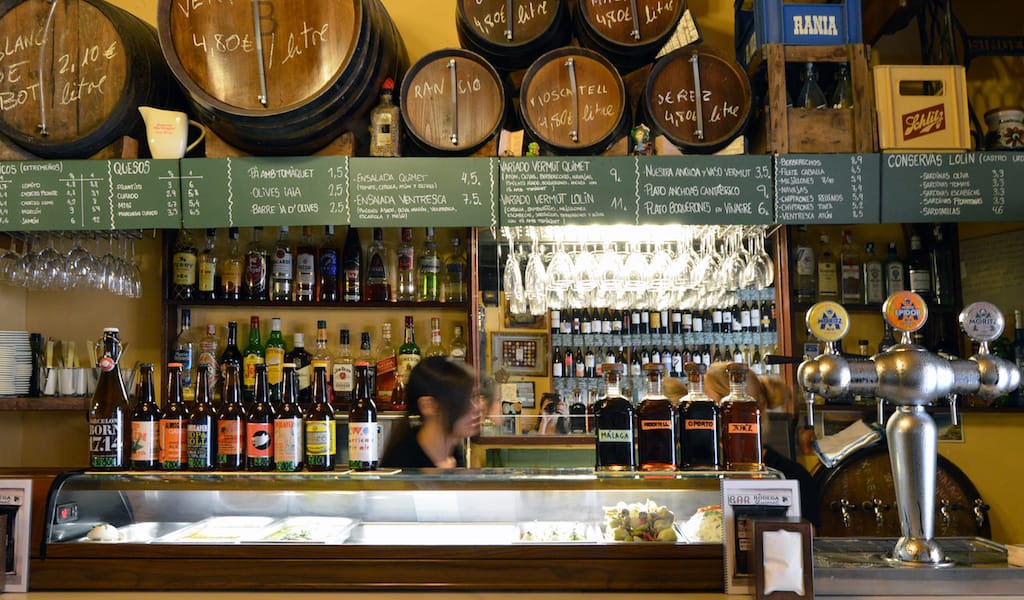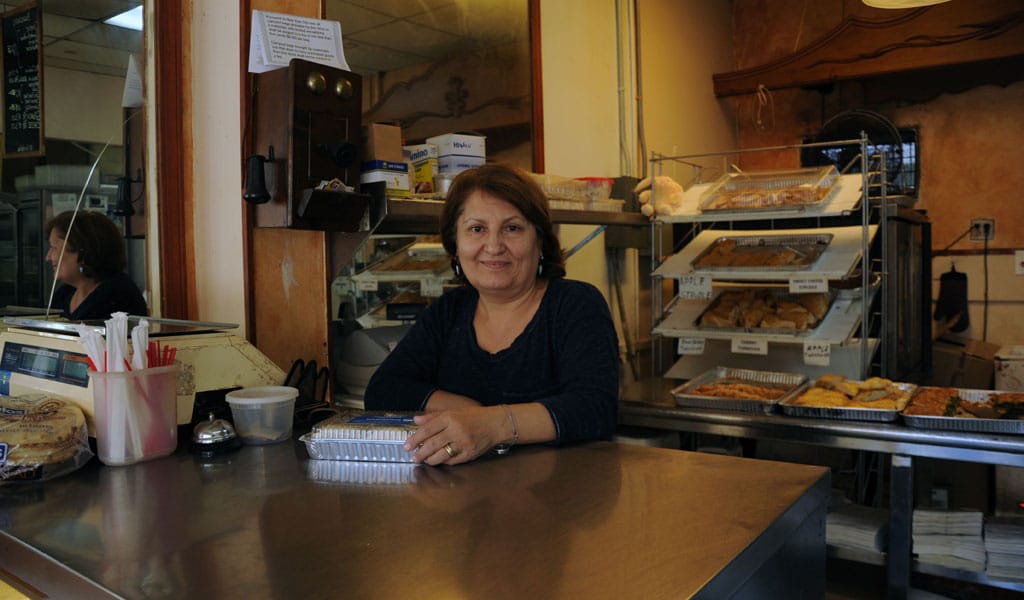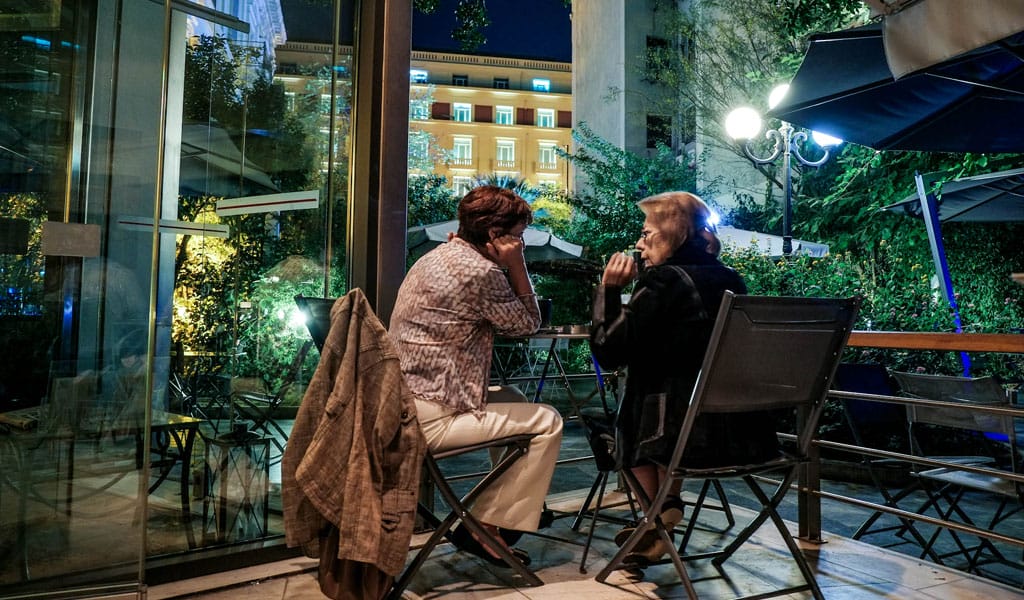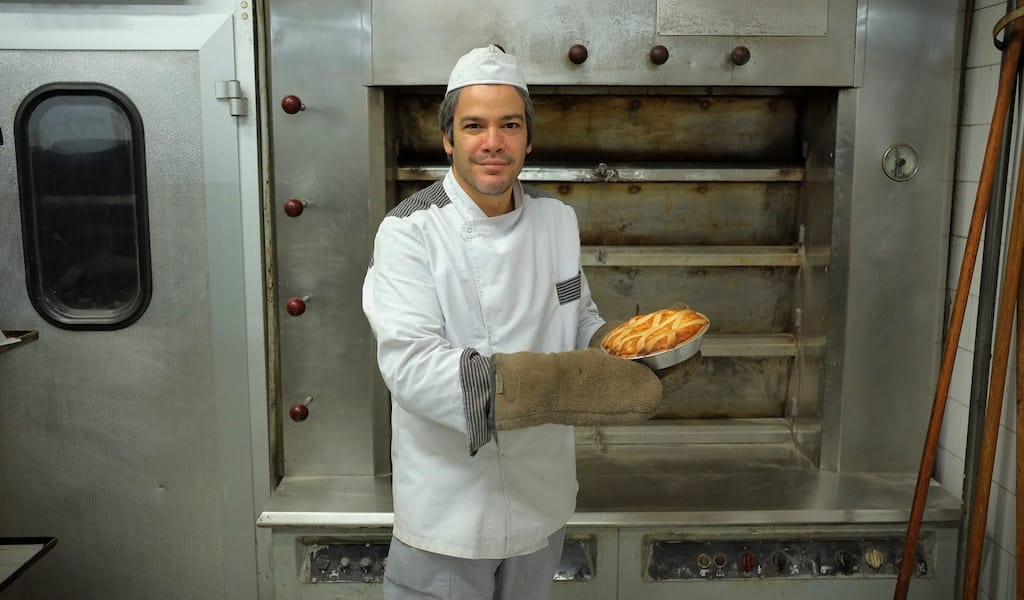Update: This spot is sadly no longer open.
The easiest way to pick out a bodega in Barcelona is to look for big wooden wine barrels – they always, and we mean always, feature prominently in these taverns. Locals frequent their neighborhood bodega for myriad reasons: some come to buy affordable bulk wine from the barrels to take home, others to have a vermut (vermouth) with anchovies, or other drinks and tapas, for an aperitif. Sometimes, in those special cases where the bodega evolved to include a kitchen, they also come to enjoy a magnificent meal.
These living monuments were, and still are, witnesses to Barcelona’s history, from the Spanish Civil War to the gentrification and intense “touristification” currently taking place in the city. If the walls of Barcelona’s bodegas could talk (sometimes these are century-old walls with unique hand-painted tiles), we would eagerly listen to the stories of neighborhood life in Barcelona over the last century, built up day after day, meal after meal, generation after generation.
These living monuments were, and still are, witnesses to Barcelona’s history.
The city is home to dozens of these iconic establishments, many of which opened in the first half of the 20th century. Some even got their start in the late 19th century, like Bodega Salvat in Sants (opened in 1885) and Bar Bodega Montse in Raval (opened in 1893). While some of these historic spots have been preserved in time, others, like Bodega Lo Pinyol in Gràcia, have been renovated to marry old-school charm with modern sensibilities.
Our favorite bodegas, though, are those that have gained a kitchen without losing the original spirit of the wine store – we want to be able to eat an excellent meal and then buy bulk wine (and vermut) from wooden barrels on our way out. Here are five of our favorite bodegas where you can do just that: eat a complete meal, drink a couple glasses of house wine and then take some for the road.
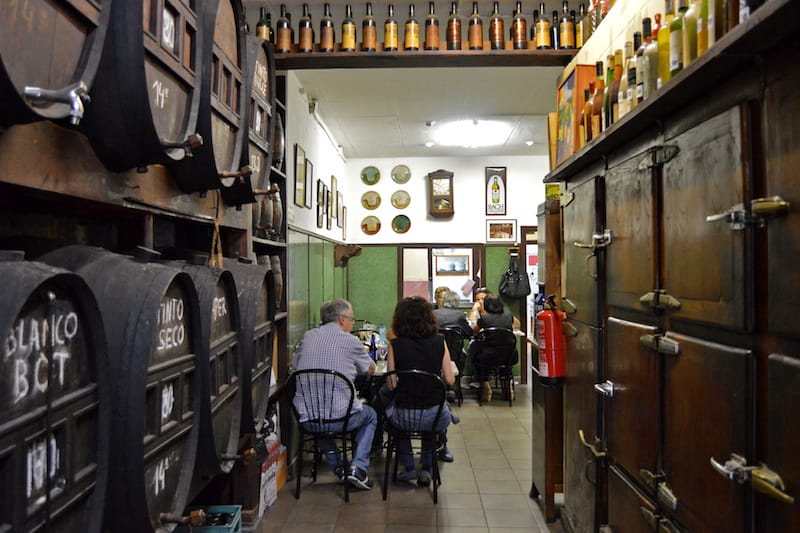
Bodega Manolo
Since 1961, Bodega Manolo has been owned by three generations of men named – what else – Manolo, although the bar’s existence stretches back much further in time. The current owner (the third Manolo in this illustrious line) is a talented cook, having learned his trade under Josep Lladonosa, head chef of iconic Barcelona restaurant 7 Portes, as well as during internships at other restaurants. So while this bodega in upper Gràcia, not far from Park Güell, may look like your average bodega at first glance, with wooden wine barrels and a bar dominating the front room, we know to venture through to the restaurant in the rear, where we can indulge in seriously delicious plates of home-cooked food.
Manolo takes traditional, high-quality Catalan ingredients and serves them in gutsy, generous portions with a creative touch. One of his classics is the anarco bravas, crispy, chunky sliced fried potatoes with a moreishly pungent garlic and squid ink sauce that are drizzled with parsley oil, tomato sauce and a further daub of briny ink on the plate. A purée of potatoes livened up with a poached egg yolk and a pork trifecta – jamón topped with morcilla (paprika-infused black pudding) and crispy bacon – goes by the winking name “Destroyer,” perhaps for the potential effect it might have on the arteries. But it’s the generous portion of pan-fried foie gras in a sweet and tangy sauce of port, braised apples and booze-soaked raisins that is really the star of the show.
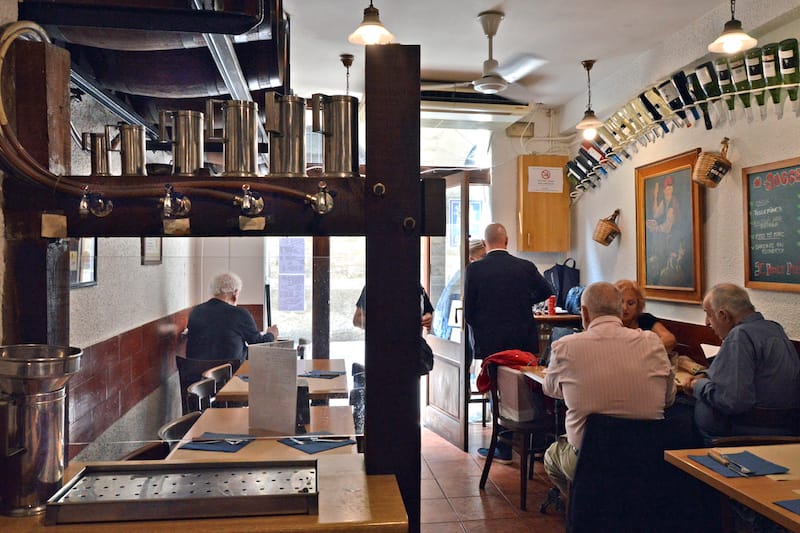
Bodega Neus
Editor’s note: We regret to report that Bodega Neus has closed.
Very close to La Llibertat market in Gràcia, this tranquil, cozy bodega merges two culinary traditions with deep roots in Barcelona: wine and seafood. Since opening in 1917, the bodega morphed from a bulk wine shop into a bar and then a restaurant. It was only in 2015, when Eduard Ampolla and his son Marc, who come from a centuries-old family of fishmongers, bought Bodega Neus, that high-quality fish and seafood dishes were introduced to the menu.
While there are non-seafood options available, like callos (pork tripe stew) and butifarra (pork sausage) with beans, the specialties from the sea steal the show. Some of our favorites are the fish suquet (traditional Catalan fish stew) and the iconic caldereta (another stew, traditionally made with lobster in Catalonia). We are also partial to the super fresh Barcelona prawns (fished from the Mediterranean in between the Catalan coast and the Balearic islands) that are sublimely simple, grilled only with olive oil, garlic and parsley. Whatever seafood or fish is on offer, it’s sure to be fresh and sustainable, as Eduard and Marc almost exclusively use seafood designated as “Peix de Custodia” by Els Canyons del Maresme, a project that offers sustainable seafood sourced from responsible local providers. It goes without saying that any meal should be washed down with the house wine stored in the bodega’s still-functioning wine barrels.

Gelida
When it opened in L’Eixample in 1946, Gelida was just a wine store where Joan Llopart Pujó, who came from the village of Gelida in Penedés, offered Catalan wine, cold cuts and a few traditional Catalan dishes cooked by his grandmother, like butifarra amb mongetas (boiled sausage with beans). In the 1960s and 1970s it became a popular spot for FC Barcelona fans who would wait for the stadium-bound bus that stopped just out front of the bodega and, as a result, club paraphernalia and photos were plastered all over the place. Nowadays Llopart Pujó’s children and grandchildren run the bodega-restaurant, which specializes in traditional Catalan cooking, particularly stews, although there are also a few salads, soups, grilled fish and salt cod dishes, plus tapas, omelets and sandwiches on the menu. In all the years Gelida has been in the neighborhood, much as changed around it, but inside, the dishes, wine barrels and Barça mementos have remained the same.
All dishes are available from morning to night, with specials changing depending on the day. Paella is served on Tuesdays, and here it’s a surf-and-turf version with ribs, squid, mussels, prawns and peas. On Friday and Saturday, Gelida serves cargols (snails) stewed in a spicy sauce made with chorizo, ham and herbs. On Wednesday, there’s pig feet. The restaurant’s most iconic Catalan dish might very well be cap i pota, the famous cartilaginous stew made with beef head and leg, plus some chorizo and a powerful sofrito to make a dense and spicy sauce that’s perfect to dip bread your bread into.
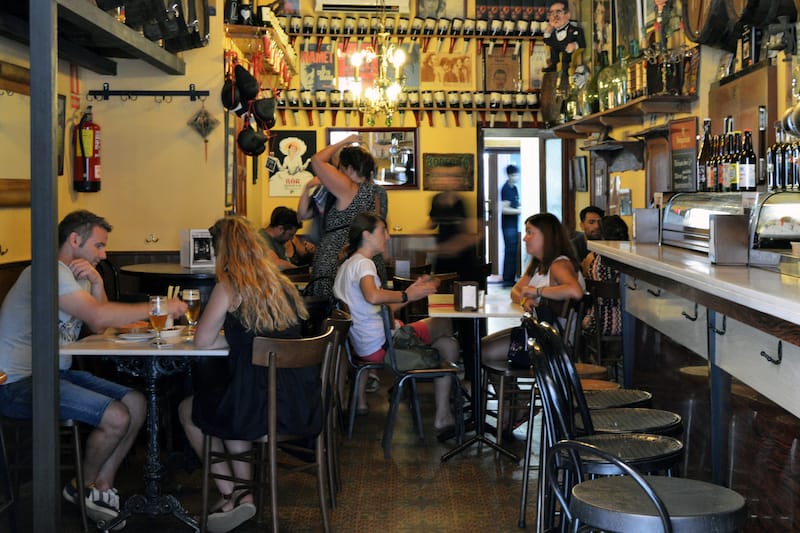
Bodega Quimet
Opened in the 1950s by the Quimet family, Bodega Quimet (not to be confused with Quimet i Quimet, a popular Barcelona tapas bar) was passed down from father to son until 2010, when the younger (but nonetheless old) Quimet retired and brothers Carlos and David Montero bought the venue.
The Montero brothers made the somewhat unusual decision to keep everything, from the low prices to the décor, pretty much the same as it always had been. This was obvious as soon as we walked through the door at Quimet. First the smell hit us: the pungent aroma of wooden tabletops that had been sloshed with many a copa de vino throughout decades of use. The floor was covered with traditional Spanish tiles, which were well worn and in some cases worn through, and the walls were lined with several large, rustic wooden barrels, all with their contents written on them in chalk: jerez, oporto, moscatel and, of course, vermut.
The bodega is well known for their high-quality embutidos (sausages) and tinned seafood (anchovies, razor clams, sardines and tuna), which make for a delectable aperitif. But its greatness mostly lies in such amazing dishes and tapas as the grilled octopus with mashed potatoes, stuffed squid with marinated vegetables, and the simple but sublime baby fava beans with Iberian ham and a poached egg.
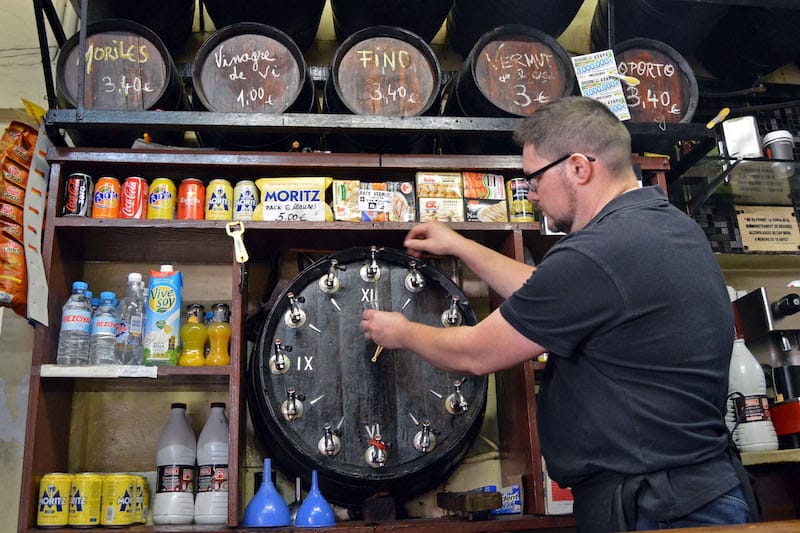
Bodega Massana
Bodega Massana has supplied Horta locals since 1930, although current owners Crescencia (Cris) and Carles de la Prida bought the place in 1996. It does a brisk wine business, selling around 1,200 liters of bulk wine per week from the shop’s 22 barrels. We particularly love the bodega’s barrel clock – the hours are marked by taps, each of which is connected by a tube to the fortified wines in the wooden barrels above. How else will you know when it’s Port O’Clock or Vermut-Thirty?
The bodega serves traditional Catalan cuisine, including such classics as butifarra (pork sausage) and beans, callos (tripe stew), snails, omelets, all kinds of meat (beef, pork, chicken and rabbit), and cold and warm sandwiches. You can also have tapas, from cured anchovies and other conservas (best paired with vermut) to Iberian ham, as well as esmorzar de forquilla, the traditional robust Catalan breakfast. We like going on Saturdays for an extended fork breakfast-lunch accompanied by house wine drunk from the porrón.
Join us for our Bodega walk in Barcelona, where we eat and drink our way through some of the city’s most iconic bodegas.
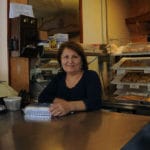 May 9, 2017 Arsi’s Pateseria
May 9, 2017 Arsi’s Pateseria
Tucked away from the constant hustle and bustle of Queens Boulevard, Anna and George […] Posted in Queens April 20, 2017 Spring Greening
April 20, 2017 Spring Greening
In terms of greenness, Athens doesn’t even come close to other European capitals, with […] Posted in Athens December 4, 2017 Ciro Pace Bakery
December 4, 2017 Ciro Pace Bakery
Sometimes we crave salty, sometimes sweet. But there are those inexplicable moments when […] Posted in Naples
Published on May 10, 2018
Related stories
May 9, 2017
QueensTucked away from the constant hustle and bustle of Queens Boulevard, Anna and George Artunian’s Sunnyside bakery, Arsi’s Pateseria, is a pleasant surprise. As we walk down 47th Avenue towards the gauzy Midtown Manhattan skyline, the smell of freshly baked burekas greets us long before we get to the bakery’s wide window. Inside, in metal…
April 20, 2017
AthensIn terms of greenness, Athens doesn’t even come close to other European capitals, with their verdant parks and blossoming gardens. The truth is, modern urban development has not been particularly gentle with this city. Numerous concrete buildings, along with poor road design, hem in inhabitants and visitors with featureless views. Thankfully, there are some oases…
Discover family-run shops on our Naples culinary walk!
December 4, 2017
NaplesSometimes we crave salty, sometimes sweet. But there are those inexplicable moments when we want both at the same time. At these moments of mixed signals, we make our way to Ciro Pace Bakery on Via Nazionale for a rustico soffiato. This perfect mix of salty and sweet is made of short pastry and pâte…







































